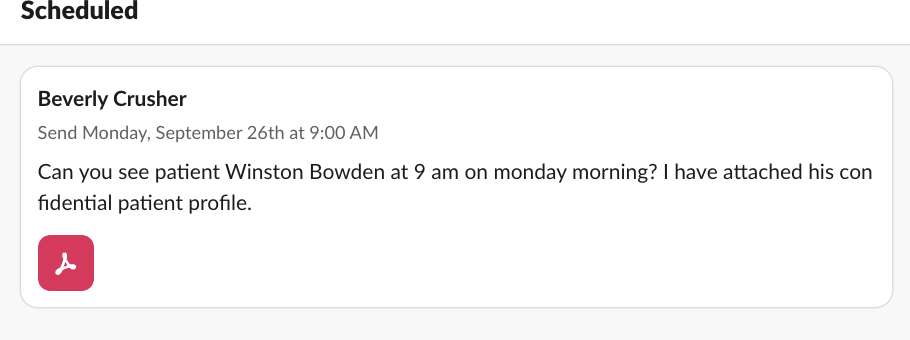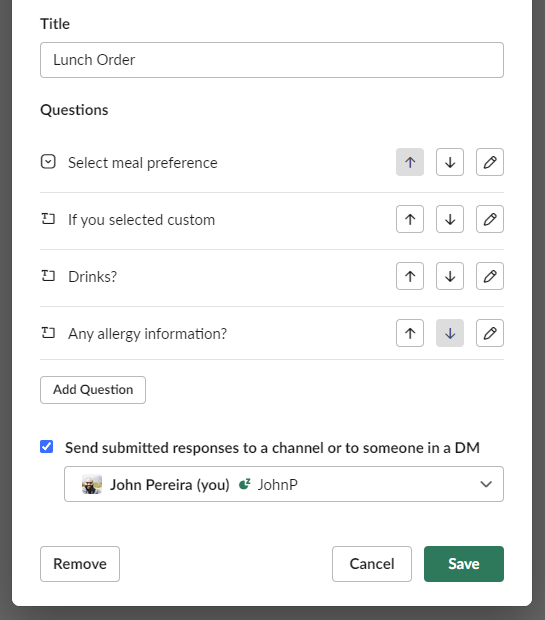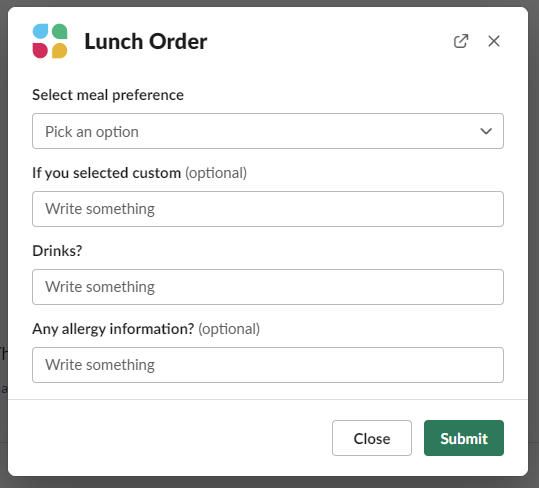How to Automate Slack Messages the Easy Way
There are lots of ways you can automate Slack messages. In this post, we'll walk you through Slack automation options step-by-step.


Every day, more than 10 million people log on to Slack and connect with their colleagues. With nearly 80% of Fortune 500 companies using Slack in one way or the other, it's a very important component of the digital strategy of many companies. Needless to say, with these kinds of numbers, using Slack effectively will pay out big dividends to you and your team.
In this post, we'll look at several different ways you can automate messages in Slack. Including these in your Slack toolkit will save you lots of time in the long run, letting you focus on what's really important to you. Let's jump right into a simple example!
Scheduling a Message to Be Sent Later
Imagine this scenario. You're working remotely in a different timezone, and you're tasked with finding ways to automate certain tasks that are currently being managed on Slack. You go through lots of different services until you hit on one that seems to be everything that you're looking for. You take a few screenshots and write out a message to your boss. The only problem is that it's really late where they live, so you don't want to risk disturbing them outside of work. Wouldn't it be handy if you could schedule a message to be sent when they are online? Well, you can easily do that with Slack.

To schedule a message:
- Type out the message as you would normally do. Once you're done, instead of hitting Enter to send it, click the downward arrow next to the send button.
- You can send it at 9 a.m. the next day, or at a custom time of your choosing.
- Once you've queued it, it'll show you a status message confirming that Slack has queued your message.

To view all the messages that are currently queued, you can click the Scheduled link on the side menu.

And that's as simple as could be. Let's look at another common use case: the repeating message.
Scheduling a Message Which Repeats Daily or Weekly
Sometimes it can be useful to send a repeating message to a single person or an entire channel. An example of this could be to remind your colleague who sits near the coffee pot to switch it on at 9 a.m. for a fresh brew. Or maybe you want to remind yourself to take 15 minutes to prepare for the weekly team-leads meeting. Once again, this is easily achieved via Slack's slash command. Specifically, the /remind command.

# To send a recurring message every day at 8:30 a.m.
/remind @john "Turn on the coffee machine, buddy" every day at 8.30am
# For a reminder every week
/remind #teamleads "Make sure your reports are ready, we meet in 15" every Monday at 9.15am
You can set a reminder for someone else using their @name, you can send it to a #channel, or you can remind yourself using me

Once you set the reminder, Slack will show you a confirmation, and you can either delete or view any currently set reminders.
If you want to list all the reminders that have currently been set, you can use the /remind list command. This will also allow you to either delete or snooze reminders that are set.

Now that we've covered a couple of simpler tricks, let's have a look at an example with more heft to it!
How to Create a Scheduled Workflow in Slack
Slack Workflow Builder helps you automate simple tasks and processes. Automating these types of tasks will save you precious time and let you focus on more important things. You can find the workflow builder shortcut in Slack, using the plus (+) menu next to the message box or by clicking on your workspace name at the top left and selecting tools.
Slack Workflow Builder works well for simple workflows, but tools like Wrangle are helpful when you’re scaling and need more functionality. Unlike Slack Workflow Builder, Wrangle’s feature set allows for multi-step custom forms, approvals, task assignments, document attachments, date fields and so much more. But if you’re new to workflows, Slack Workflow Builder will give you a taste of how automation can help you save time. To get started:

Clicking the Open Workflow Builder option will take you to a screen that shows you all your existing workflows.
An Example Workflow to Order Lunch
Let's run through an example. Imagine you're the one responsible for ordering everyone's lunch every day. People generally send you their lunch orders on Slack, but sometimes people forget or are too late, and then you miss out on ordering for them. One way you could automate this is to create a #lunch-orders channel and then set up a reminder using the previously discussed /remind command. But that can get a little messy, because you're going to end up with a lot of random messages from colleagues.
Wouldn't it just be easier to send them a structured form at a given time, asking what they want to have for lunch? Well, that's easy to do! Just follow these steps:
- Click on the Open Workflow Builder option, and then click on the Create button on the workflow list page.
- Give your workflow a name: Lunch Order Reminder.
- Select Scheduled date & time in the Choose a way to start this workflow screen.
- In the next screen, select the date and time you want to start the workflow on. Since these are lunch order reminders, let's set it to 11 a.m. And then set the frequency to Every Weekday so that it repeats every day at work.
- You should now see the Workflow screen, where you can start adding steps.

Adding Automation Steps to Your Example Workflow
Next, we want to send out a form to everyone so that they can easily make the selection. To make this easy, we're going to create a channel named #lunch-orders and add anyone who wants to have lunch ordered for them into the channel.
- Click the Add Step button to add a new step to your workflow, and select Send a form.
- Select the #lunch-orders channel in the Send this form to: dropdown.
- Fill in some message text to send along with the form so that people know they need to submit their orders.
- Your updates should look something like what's shown below.

Once we have that set up the way we like, we're going to add the questions. In this example, we're going to add four questions.
- Give your form a title: Lunch Order.
- Click on the Add Question button and add a list with a few meal options. I also added a Custom option.
- Add a short text box to capture a Custom option (if any), their drinks order, and then any allergy information.
- Select where you want the submitted options to be sent, either to a specific channel or to a person.
- The final result should look something like what's shown below.

Make sure to save the form and click on the Publish button on top. Now, let's see what the end result looks like.
Submitting Your Lunch Orders
Once 11 a.m. rolls around, the #lunch-orders members should now see a new message with the option to submit an order.



Wasn't that simple? In a few minutes, you automated the process of capturing everyone's lunch orders. No more hassle. Now let's look at an example that's based on a trigger, rather than being based on time.
How to Create a Triggered Workflow in Slack
In addition to using time-based workflows, Slack allows you to create manual workflows and triggered workflows. Triggered workflows are started based on some event. You can find out more details about that in their guide. Let's look at a quick example.

Let's imagine that you're the team lead of a team, and you have a well-documented onboarding process for new team members. Your team is already on Slack, and new hires usually open up Slack as their first port of call. Wouldn't it be nice to send them a friendly welcome message when they join the team channel?
We can do this easily with the New channel member workflow.
- Create a new workflow, and select the New channel member option.
- Select which channel should act as the trigger. This workflow will be triggered any time a new person is added to this channel.
- Add a Send a message to the workflow, and select Person who joined channel as the answer to the Send this message to: dropdown.
- Fill in the message, and then click Save and Publish.

Taking It to the Next Level
Slack is an incredible tool for communication and collaboration, and while their workflows are useful, Wrangle can help super-charge them so they scale as your organization grows.
Companies worldwide use Wrangle to automate common processes like employee onboarding, IT ticketing, finance approvals, creative reviews and so much more. If it’s a repeatable business process, there’s a way to automate it with a Wrangle workflow.
We think you’ll find that Wrangle’s automated workflows provide more functionality than Slack Workflow Builder alone. Here are a couple of areas where Wrangle brings added value.
- Auditing is challenging using Slack Workflow Builder. There’s very little record of when an approval occurs. You have to sift through a long history of Slack conversations to find the emoji that indicated an approval. Wrangle provides a comprehensive history of your approvals that can be exported for auditing purposes.
- Multi-step approvals aren’t as seamless when using Slack Workflow Builder. You need to string multiple workflows together for approvals, where Wrangle handles this seamlessly in our web-based workflow editor.
- Task management isn’t as robust in Slack Workflow Builder. For example, if a process has a set of specific tasks, you can’t create a task list and assign it to an individual to complete. Wrangle allows you to build workflows with a pre-set list of tasks to be completed with the workflow, and Wrangle workflows automatically assign to the right individuals.
- Analytics and dashboards are lacking in Slack Workflow Builder. Wrangle provides you with two different methods of reviewing your workflows, tasks, and approvals. In Slack, you’ll find the Wrangle dashboard, which shows you all the tasks and approvals you’ve assigned and those you need to take action on. If you’re a workflow agent, the Wrangle web application provides you a singular place to manage all your work, and you can even take action on tickets and requests in the web application, which will then be reflected in your Slack channels.
- File attachments aren’t available in Slack Workflow Builder. Wrangle allows you to add a step that lets your users add documents and attachments, which is critical when your workflow is used for document review and approvals.
Time is the only thing that we can't make more of, so you need to guard those precious seconds. Be sure to make every second count by stripping the cruft from your work by adding Wrangle to Slack. It’s free to try.
This post was written by John Pereira. John is a technology enthusiast who's passionate about his work and all forms of technology. With over 15 years in the technology space, his area of expertise lies in API and large scale web application development, and its related constellation of technologies and processes.

- Try Wrangle free for 14 days
- Turn messages into trackable tickets
- Build a scalable help desk



Turn Slack into a productivity powerhouse with Wrangle
Create a scalable helpdesk in Slack. Automatically turn messages into trackable tickets and provide faster, more transparent service to your colleagues and customers with Wrangle — Try it free!






